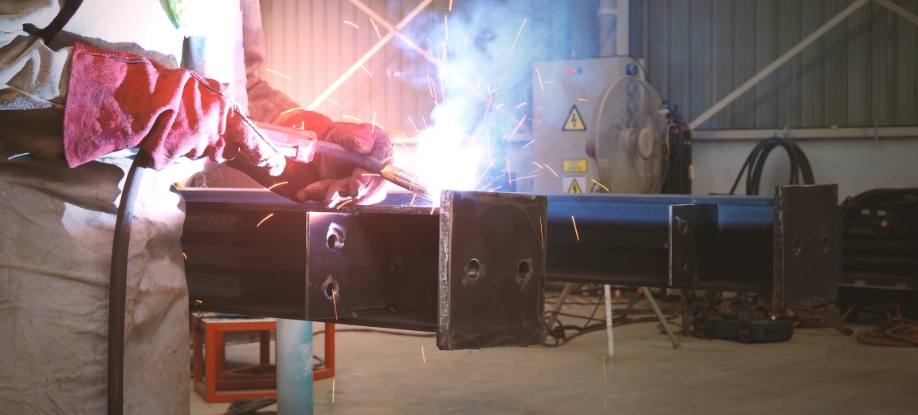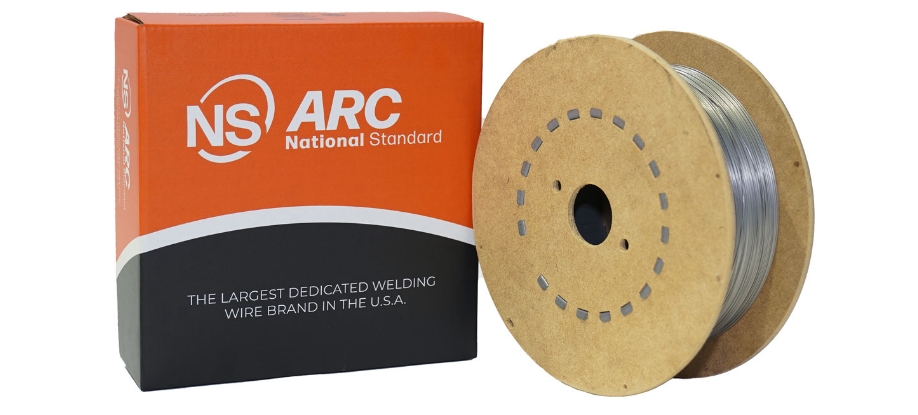Which Electrode Is Used to Weld Stainless Steel?
Aug 31st 2023
The choice of the right electrode or welding wire is of paramount importance to achieve impeccable results when welding stainless steel. So which electrode is used to weld stainless steel? Among the various options available, stainless-steel welding wire stands out as a primary electrode choice when joining two pieces of stainless steel. However, the decision-making process does not end there; understanding the nuances and distinct advantages of different electrodes or welding wires is crucial in making an informed choice for your specific stainless-steel welding applications.
This article will delve into the realm of electrodes and welding wires for stainless steel by exploring the three most commonly used types: MIG, TIG, and flux-cored wires. We will uncover the unique characteristics and benefits that each of these welding wires offers, enabling you to make the most pertinent choice for your stainless-steel welding projects. Whether you are a seasoned welder or a newcomer to the world of stainless-steel welding, this guide will provide you with valuable insights to enhance your welding expertise and elevate the quality of your stainless-steel welds.
Which Filler Metal Is Best for Welding Stainless Steel?
For optimal results, it is essential to use a filler metal that matches the base material. While it is true that stainless steel can be welded using carbon steel welding wire, it is generally recommended to utilize stainless-steel welding wire for superior performance and weld quality. The reason behind this preference lies in the unique properties of stainless steel. By using stainless-steel welding wire, you ensure a seamless fusion of similar alloy compositions, leading to stronger and more resilient welds. Using the appropriate stainless-steel electrode guarantees that the weld will possess the same corrosion resistance, high-temperature stability, and mechanical properties as the base material, promoting long-lasting and durable weld joints.
Stainless-Steel MIG Welding Wire – Benefits
MIG welding stands out for its user-friendly and straightforward nature, making it a favored option among welders of all skill levels, from novices to experts. Beyond its simplicity, stainless-steel welding wires for MIG welding offer decent deposition rates, enabling faster welding speeds and heightened productivity during projects. Additionally, when executed with proper settings and techniques, stainless-steel MIG welding yields a pleasing bead appearance, adding to the aesthetics of the finished weld. Another advantage lies in the minimal slag produced by MIG welding, distinguishing it from other processes. As a result, MIG welding emerges as a simple, efficient, and effective method for achieving clean welds while keeping productivity relatively high.
Quick List – What Are the Benefits of Stainless-Steel Wires for MIG Welding?
The benefits of using stainless-steel MIG welding wire include:
- Simplicity
- Decent Deposition Rates
- Decent Bead Appearance
- Minimal Slag

Welding Tips for Using Stainless-Steel MIG Welding Wire
When using stainless-steel MIG welding wire, it is essential to select the right wire alloy and size to achieve optimal results. A popular choice is ER309L stainless-steel welding wire, known for its excellent performance in stainless-steel welding applications. However, to ensure the best match for the specific welding project, it is highly recommended to consult a welding wire chart.
Regarding choosing the right shielding gas for stainless-steel MIG welding, opting for a tri-mix of helium, argon, and carbon dioxide is a suitable option as it provides the necessary protection and stability for the welding process. It's important to avoid using pure inert gases like helium or argon, as they may not offer the desired results for stainless-steel MIG welding. By selecting the appropriate shielding gas, welders can enhance the overall quality of their welds, improve penetration, and reduce the risk of welding defects.
Stainless-Steel TIG Welding Wire – Benefits
TIG welding boasts an array of advantages tailored for stainless-steel welding. With stainless-steel welding wires for TIG welding, welders can achieve high precision in heat control, allowing them to fine-tune the heat output and minimize the heat-affected zones during the welding process. This precise control over the heat, combined with the ability to add filler material separately, results in the best possible bead appearances with minimal spatter, enhancing the overall aesthetics of the weld.
Moreover, TIG welding excels in minimizing discoloration and oxidation, which can be common challenges in stainless-steel welding with other methods. In addition, TIG welding generates minimal to zero slag, streamlining the post-welding cleanup and ensuring pristine welds. These attributes make TIG welding a prime choice for stainless-steel projects that demand exceptional precision, appearance, and cleanliness, provided the welder is skilled enough to properly execute TIG welding techniques.
Quick List – What Are the Benefits of Stainless-Steel Wires for TIG Welding?
The benefits of using stainless-steel TIG welding wire include:
- Precise Heat Control
- Optimal Bead Appearance
- Welding Discolored Stainless Steel
- Minimal to Zero Slag

Welding Tips for Using Stainless-Steel TIG Welding Wire
Ensure that the TIG welding wire chosen for your project matches the correct alloy and base material for the specific stainless-steel welding project. In most cases, using stainless-steel welding wire proves to be the ideal choice for welding stainless steel, as it ensures compatibility and facilitates a smoother welding process.
In addition to the welding wire, the choice of a suitable tungsten electrode is equally essential for successful TIG welding stainless steel. It is necessary to select the tungsten electrode based on the welding amps and the thickness of the base metal. By using the correct tungsten electrode, welders can achieve precise heat control, minimize the heat-affected zones, and produce clean, aesthetically pleasing weld beads with minimal spatter.
To further enhance the welding process, the appropriate shielding gas should be chosen. While pure argon is the most common shielding gas for stainless-steel TIG welding, other gas mixtures like helium, nitrogen, and hydrogen can be used to achieve specific welding properties. Welders are encouraged to consult a TIG welding shielding gas chart to determine the best gas mixture based on the type of stainless steel being welded.

Stainless-Steel Flux-Cored Welding Wire – Benefits
Gas shielded flux-cored welding wires offer distinct advantages for welding stainless steel. With these wires, welders can achieve high deposition rates due to the shielding and alloying elements provided by the flux within the wire, promoting efficient molten metal transfer during the welding process. This results in faster welding speeds and increased productivity.
Additionally, the flux acts as a protective shield, safeguarding the weld pool from atmospheric interference, ensuring consistent and reliable weld quality even in challenging environmental conditions. Moreover, the flux contains compounds that aid in the removal of surface contaminants, making it suitable for welding when the base material may have light rust or mill-scale or a thin coating of oil. This capability further enhances the versatility and effectiveness of gas shielded flux-cored electrodes, making them a valuable choice for various stainless-steel welding applications.
Quick List – What Are the Benefits of Stainless-Steel Flux-Cored Wires?
The benefits of using stainless-steel flux-cored welding wire include:
- High Deposition Rates
- Welding Dirty or Rusty Stainless Steel

Welding Tips for Using Gas-Shielded Stainless-Steel Flux-Cored Welding Wire
Consider the flux composition, as well as the alloy and thickness of the base material when selecting the appropriate flux-cored welding wire for welding stainless steel. Also, ensure you have the appropriate shielding gas on hand when using gas-shielded flux-cored welding wire for stainless-steel projects.
Even though it may not be required for some other types of welds, shielding gas is crucial when using gas-shielded flux-cored electrodes for welding stainless steel due to the metal's distinctive properties. Common mixtures for flux-cored welding wires used in stainless-steel welding include 100% CO2 or a 75% argon, 25% CO2 mixture. Consult a welding wire chart to find the suitable gas mixture for the specific stainless-steel alloy and thickness being welded.
Flux-cored welding wire can produce more slag and by-products during the welding process. To prevent defects like porosity or excessive oxidation, maintain post-weld shielding gas coverage and flow for a few seconds after welding. This practice ensures the weld's integrity.
NS ARC Stainless-Steel Welding Wires
If you’re looking for a quality stainless-steel welding wire for your next welding project, look to NS ARC Satin Glide® stainless-steel welding wires. This welding wire boasts excellent corrosion resistance, ensuring clean welds that stand the test of time in harsh environments. Its superior strength and high-temperature resistance provide consistent integrity for welded joints. Whether you're working on agricultural equipment, auto body, automotive exhaust, general fabrication, heavy equipment, pipe welding, pressure vessels, railcars, shipbuilding, structures, trailers, or more, this versatile stainless-steel welding wire excels across diverse industries.
With Satin Glide® stainless-steel welding wire, you can achieve efficient and precise welding processes thanks to its compatibility with mechanized, robotic, and semi-automatic methods. NS ARC delivers a superior solution that ensures high weld performance while exceeding the highest industry standards.
Become a master of welding stainless steel with the help of our easy-to-follow guide!
Learn MoreDISCLAIMER: This information is descriptive in nature and not purely prescriptive. Refer to your own welding machine’s user manual for proper settings and consult a welding expert for support.



